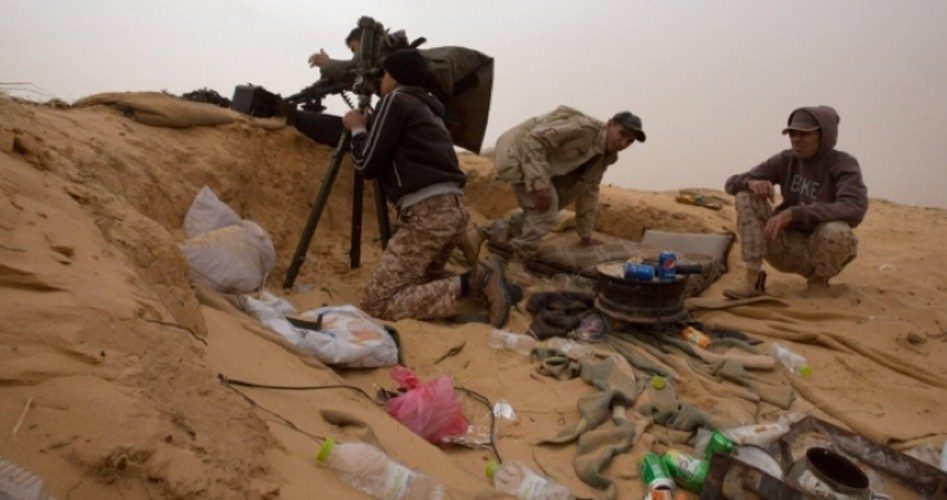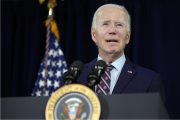
The leader of the al-Qaeda-linked rebel forces that brought down Moammar Gadhafi is now the Islamic State’s top man in Libya, according to various media reports, indicating a further unraveling of the Pyrrhic victory achieved by the U.S. and NATO air war on Libya in 2011.
Abdelhakim Belhadj, a Libyan known in the jihadi world as Abu Abdullah al-Sadiq, is the former head of the Libya Islamic Fighting Group and the Tripoli Military Council. Prior to that he was an al-Qaeda leader in Afghanistan. Now he is reported to be organizing a jihadi effort in Libya on behalf of the Islamic State of Iraq and the Levant, the militant group that has captured cities in Iraq and portions of Syria while conducting gruesome videotaped beheadings and the burning alive of a Jordanian pilot. According to a recent Fox News report, Belhadj is believed to be among more than a dozen Islamic State fighters now in Libya, some with direct ties to the group’s leader, Abu Bakr al-Baghdadi. Director of National Intelligence James Clapper recently told the Senate Armed Services Committee that Libya has become a haven for the Islamic State and several other jihadi organizations.
“There are, in addition to ISIL, probably six or eight other terrorist groups that have gathered in Libya,” Clapper said. “So it’s a magnet because, essentially, it’s ungoverned.”
It’s been ungoverned for the most part since the overthrow of the Gadhafi regime, the unstated but obvious goal of the U.S.-NATO bombing campaign that President Obama described to the nation as a humanitarian effort to save both rebel forces and civilians in the city of Benghazi from being slaughtered by Gadhafi’s forces.
State Department spokeswoman Marie Harf said last week U.S. policy is not to blame for the ongoing chaos in Libya. “Are we happy with the situation in Libya from a governance and security perspective? No. Absolutely not,” spokeswoman Harf told reporters. “At the end of the day, though, this is not just a line, it’s true: This is ultimately up to the Libyan people, leaders in Libya to take the security of their country into their own hands and try to move it in a better direction with our help, the U.N. and others’ help as well.”
War? What War?
Libya probably couldn’t stand much more of the type of help it has received from the United States, the United Nations, “and others.” The bombing campaign of 2011 was ostensibly undertaken in pursuance of UN Security Council Resolution 1973, which authorized member nations to impose an economic embargo against the Libyan government and enforce a no-fly zone against its air force. In the opening hours of the campaign, an American submarine, the USS Florida, launched 100 cruise missiles against Libyan air defenses. Gadhafi’s compound and his military and intelligence headquarters were among the targets for airstrikes. All of which might be fair game in war, but not only was this an undeclared war in American constitutional terms, the Obama administration insisted it wasn’t a war at all.
At the State Department, acting deputy spokesman Mark Toner told reporters it was “a combat mission, clearly,” but unclearly, not war. “So it’s not a war; it’s a frontloaded combat mission that’s obviously going to recede into a coalition,” he said. Deputy National Security Advisor for Strategic Communications Ben Rhodes un-clarified it further during a press briefing aboard Air Force One. “So it’s not a war; it’s a kinetic military action that is time-limited and contribution-limited on the front end,” he explained. President Obama had his own reasons for insisting that bombing another nation’s air defenses, military headquarters, and the president’s compound should not be considered acts of war that require congressional authorization. Three months into the receding, kinetic non-war, the White House issued a report, explaining why the president need not comply with the War Powers Resolution requiring a president to seek authorization of Congress for combat missions within 60 days of the beginning of hostilities.
“U.S. operations do not involve sustained fighting or active exchanges of fire with hostile forces, nor do they involve U.S. ground troops,” the report said. House Speaker John Boehner spoke of Congress’s “power of the purse” and said cutting off funding for operations in Libya was “an option.” Congress, predictably, did nothing. Senate Republicans John McCain of Arizona and Lindsey Graham of South Carolina led the chorus of hawks criticizing the president for “leading from behind” and not bombing Libya enough. When the Gadhafi regime was toppled, McCain and Graham released a statement congratulating the British and French but expressing “regret that this success was so long in coming due to the failure of the United States to employ the full weight of our airpower.” The mood at the White House was triumphant at the Libyan dictator’s downfall, less than three months after a detachment of Navy SEALS found and killed Osama bin Laden in Pakistan. “Reagan targeted Gaddafi; George W Bush targeted Bin Laden,” one official said. “Obama has done both.”
From the Frying Pan…
Yet it was a costly victory, not so much for the billion or so the campaign added to the debt of the American taxpayers, but for the Libyan people, who were rescued from Gadhafi’s frying pan only to land in the jihadist fire. More than two years later, The New American noted on September 18, 2013, “Multiple tribal conflicts are raging, arms from the war are boosting Islamists across the region, oil production has all but come to a halt, and chaos still reigns alongside sharia law in Libya under the Muslim Brotherhood-dominated central government.”
In between, a well planned, well executed, heavily armed attack on the State Department “Special Mission” in Benghazi on September 11, 2012, destroyed the facility and killed four Americans, including U.S. Ambassador to Libya Christopher Stevens. The militants also targeted a covert CIA outpost slightly more than a mile from the State Department mission. Stevens had been the U.S. liaison to the al-Qaeda-linked rebel forces in during the revolution, when he was working directly with Abdelhakim Belhadj, the man now believed to be leading the Islamic State effort in Libya. Returning to Libya as ambassador in the spring of 2012, Stevens took up residence at the embassy in Tripoli and had not visited the State Department mission in Benghazi prior to September 10, the night before the attack. The reason for his visit soon became the subject of much speculation.
On October 14, 2012, barely a month after the Benghazi attack, the New York Times reported on shipments of arms to rebel groups in Syria through what the Times called “a shadowy pipeline with roots in Qatar, and, to a lesser degree, Saudi Arabia.” Most of the arms were “going to hard-line Islamic jihadists, and not the more secular opposition groups that the West wants to bolster,” the report said. The following year, on June 21, the Times reported on a “multinational effort, financed largely by Qatar, to transport arms from Libya to Syria’s opposition fighters. Libya’s own former fighters, who sympathize with Syria’s rebels, have been eager collaborators.”
Frank Gaffney, president of the Center for Security Policy and a Washington Times columnist, wrote shortly after the Benghazi attack that once Stevens became ambassador to “the new Libya run by Mr. Belhadj and his friends,” he faced the task of finding and securing armaments Gadhafi had stashed at various locations around the country, and which caches had been looted by rebel forces during and after the revolution.
“One of the places in Libya most awash with such weapons in the most dangerous of hands is Benghazi,” Gaffney wrote. “It now appears that Stevens was there — on a particularly risky day, with no security to speak of and despite now copiously documented concerns about his own safety and that of his subordinates — for another priority mission: sending arms recovered from the former regime’s stocks to the ‘opposition’ in Syria. As in Libya, the insurgents are known to include al Qaeda and other Shariah-supremacist groups, including none other than Abdelhakim Belhadj.”
Talking Turkey
The Telegraph of London reported in November 2011 that Belhadj met with Free Syrian Army leaders in Istanbul and on the Turkey-Syria border on a mission from Mustafa Abdul Jalil, then the interim Libyan president. The revolutionary Libyan authorities offered money and weapons to the insurgents fighting against Syrian President Bashar al-Assad, and Belhadj had also discussed sending Libyan fighters to train rebel troops, according to the report. “Having ousted one dictator, triumphant young men, still filled with revolutionary fervour, are keen to topple the next,” the Telegraph said.
A secret trip to Turkey in September 2012 by then-CIA Director David Petraeus raised further questions about that “shadowy pipeline” of arms flowing to Syria. That same month a Libyan ship carrying 400 tons of weapons for Syrian rebels docked in southern Turkey. The ship’s captain was “a Libyan from Benghazi” who worked for the new Libyan government. “The man who organized that shipment, Tripoli Military Council head Abdelhakim Belhadj, worked directly with [Ambassador] Stevens during the Libyan revolution, Business Insider reported. The shipment reportedly included mortars, rocket propelled grenades, anti-tank missiles, and the controversial anti-aircraft heat-seeking SA-7 missiles to counter Assad’s bombing campaign.
According to investigative reporter Seymour Hersh, Petraeus ran an operation the CIA called a “rat line” for supplying weapons from Gadhafi’s arsenal to the Syrian fighters. The funding came from Turkey, Saudi Arabia, and Qatar, Hersh wrote, with the CIA and its British counterpart, MI-6, responsible for delivering the arms. A “highly classified annex” to the Senate Intelligence Committee report on the Benghazi attack revealed the “rat line” was the product of a secret agreement reach in early 2012 between the Obama administration and the government headed by President Recep Taypip Erdogan of Turkey, Hersh said. A spokesman for Petraeus denied the operation ever took place.
Regime Change Redux
With or without a “rat line,” it’s clear the Obama administration — “the most transparent administration in history,” according to the president himself — was involved in a secret operation to arm one side of a civil war in Syria, soon after its undeclared war in Libya backfired on the United States. And it’s also clear that much of that arms supply went to some of the same organizations that fought the U.S. and coalition forces in Iraq and have since joined forces with the Islamic State to spread more death and destruction throughout the Middle East and possibly beyond. The last three regime changes (Afghanistan, Iraq, Libya) have not worked out well for the United States. Another in Syria, should it happen, does not look any more promising.
There is another lesson to be learned from the Libya campaign, one described at the time by Michael Boyle writing in British newspaper The Guardian. In the same year U.S. and coalition forces launched the war on Iraq, Boyle recalled, Gadhafi agreed to surrender his own weapons of mass destruction in return for trade and diplomatic relations with the United States and Europe.
“Before he surrendered his weapons programme in 2003,” Boyle wrote, “Gaddafi was courted and threatened, but his regime remained intact; without them, he was cast aside as soon as a credible alternative appeared. After this experience, Iran, Syria and similar regimes may conclude that surrendering their weapons programmes or even opening themselves up to the west carries more dangers than it does rewards. It is one thing to withdraw support from a dictator who was past his sell-by date, but it is quite another to militarily back the overthrow of a regime if the consequence is to accelerate the nuclear arms race in the Middle East.”
Photo of Libyan soldiers fighting militants: AP Images


